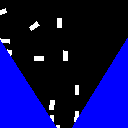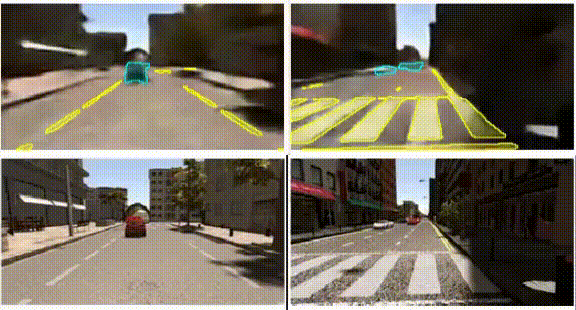Neuro-inspired Circular Latent Space for Rotation Estimation
2023
With this work, I proposed a neural network model that estimates the rotation angle of unknown objects from RGB images using an approach inspired by biological neural circuits. The model embeds the understanding of rotational transformations into its architecture, in a way inspired by how rotation is represented in the ellipsoid body of Drosophila flies. To effectively capture the cyclic nature of rotation, the network's latent space is structured in a circular manner. The rotation operator acts as a shift in the circular latent space's units, establishing a direct correspondence between shifts in the latent space and angular rotations of the object in the world space. The model accurately estimates the difference in rotation between two views of an object, even for categories of objects that it has never seen before. For further details, see [Plebe & Da Lio, 2023].


Distributed Cognition for Human-vehicle Collaboration
2021 - 2022
This work proposed a collaboration mechanism grounded on the concept of distributed cognition. With distributed cognition, intelligence does not lie just in the single entity but also in the interaction with the other cognitive components in a system. We applied this idea to vehicle intelligence, proposing a system distributed into two cognitive entities—the human and the autonomous agent—that together contribute to drive the vehicle. The proposed mechanism follows one of the paradigms derived from distributed cognition, the rider-horse metaphor: just like the rider communicates their intention to the horse through the reins, the human influences the agent using the pedals and the steering wheel. We used a driving simulator to demonstrate the collaboration in action, showing how the human can communicate and interact with the agent. For futher details, see [Plebe et al., 2022] and [Da Lio et al., 2022].




Reinforcement Learning for Safe Interaction with Distracted Pedestrians
2021
Driving requires the ability to handle unpredictable situations. Considering the possibility of a pedestrian suddenly crossing the road, a prudent driver should limit the traveling speed. This work used reinforcement learning to learn a function that specifies the safe speed limit for a given artificial driver agent. The safe speed function acts as a behavioral directive for the agent, thus extending its cognitive abilities. We considered scenarios where the vehicle interacts with a distracted pedestrian that might cross the road in hard-to-predict ways. We proposed a neural network mapping the pedestrian's context onto the appropriate traveling speed so that the autonomous vehicle can successfully perform emergency braking maneuvers. There are advantages in developing a specialized neural network extension on top of an already functioning autonomous driving system, such as removing the burden of learning to drive from scratch while focusing on learning safe behavior at a high-level. We demonstrated that the safe speed function can be learned in simulation and then transferred into a real vehicle. For further details, see [Rosati Papini et al., 2021].
Neuro-inspired Occupancy Grid Mapping of Driving Scenarios
2020
The mechanisms behind human perception could provide cues on how to improve common techniques employed in autonomous navigation, such as the use of occupancy grids to represent the environment. I experimented with neural networks that map an image of the scene onto an occupancy grid representation. The results showed how the model benefits from two key (and yet simple) changes: 1) a different format of occupancy grid that resembles the way the brain projects the environment into a warped representation in the cortical visual area; 2) a mechanism similar to human visual attention that filters out non-relevant information from the scene. These effective expedients can potentially be applied to any autonomous driving task requiring an abstract representation of the scenario like the occupancy grids. For further details, see [Plebe et al., 2021].


Cognitive-inspired Visual Perception for Autonomous Driving
2018 - 2019

This work constituted the primary focus of my PhD study. I drew inspiration from two theories concerning the human mind and its neural organization. The first theory pertains to how the brain utilizes structures of neurons to expand and compress information, extracting abstract concepts from visual experiences. The second theory posits that neural perceptual representations are not neutral but serve the function of predicting future states of the environment and planning future actions. I identified a correspondence between the first theoretical idea and convolutional autoencoders. Then, I translated the second theory into a training procedure, achieving successful learning of compact representations, with as few as 16 neural units for each of the two fundamental driving concepts: vehicles and lanes. For further details, see [Plebe & Da Lio, 2020].
Interior Lighting Design with Genetic Algorithms
2017
Lighting design for interior spaces is the process of integrating artificial light sources into architectural complexes. If one takes into account other criteria besides the adequate amount of illumination, such as energy saving, lighting design can be formulated as a multi-objective optimization problem, which can be tackle with genetic algorithms. This work was the result of my master thesis in which I experimented with the training of genetic algorithms within a simulated 3D environment rendered using physically-based ray tracing. I adopted the CG software Blender to reproduce the architectural space and simulate the effect of illumination. Then, I implemented a variant of the NSGA-II genetic algorithm to optimize locations and intensities of the light sources while keeping the energy consumption to a minimum. For further details, see [Plebe & Pavone, 2017].


Simulating Fire Outbreaks in Industrial Environments
2016
This work started as a continuation of my bachelor thesis on computational geometric algorithms for real-time calculation of the minimum separation distance between poliedra. I adopted the same algorithms developed in my thesis in a novel system to simulate in 3D the risk of fire outbreaks in complex industrial plants. The system uses the 3D CG software Blender to render the high-quality model of a real oil refinery and to simulates the dynamics of the flames. Then, the proposed algorithm predicts how the heat affects critical components of the industrial plant depending on their proximity. This system has later been integrated into a wider framework for risk assessment and emergency management. For ruther details, see [Plebe & Grasso, 2016].

